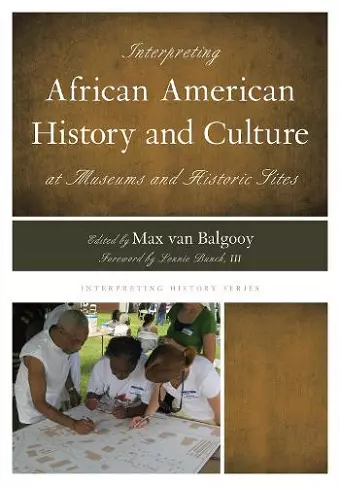Interpreting African American History and Culture at Museums and Historic Sites
Format:Hardback
Publisher:Rowman & Littlefield
Published:24th Dec '14
Currently unavailable, and unfortunately no date known when it will be back
This hardback is available in another edition too:
- Paperback£39.00(9780759122796)

In this landmark guide, nearly two dozen essays by scholars, educators, and museum leaders suggest the next steps in the interpretation of African American history and culture from the colonial period to the twentieth century at history museums and historic sites. This diverse anthology addresses both historical research and interpretive methodologies, including investigating church and legal records, using social media, navigating sensitive or difficult topics, preserving historic places, engaging students and communities, and strengthening connections between local and national history. Case studies of exhibitions, tours, and school programs from around the country provide practical inspiration, including photographs of projects and examples of exhibit label text. Highlights include: •Amanda Seymour discusses the prevalence of "false nostalgia" at the homes of the first five presidents and offers practical solutions to create a more inclusive, nuanced history. •Dr. Bernard Powers reveals that African American church records are a rich but often overlooked source for developing a more complete portrayal of individuals and communities. •Dr. David Young, executive director of Cliveden, uses his experience in reinterpreting this National Historic Landmark to identify four ways that people respond to a history that has been too often untold, ignored, or appropriated—and how museums and historic sites can constructively respond. •Dr. Matthew Pinsker explains that historic sites may be missing a huge opportunity in telling the story of freedom and emancipation by focusing on the underground railroad rather than its much bigger "upper-ground" counterpart. •Martha Katz-Hyman tackles the challenges of interpreting the material culture of both enslaved and free African Americans in the years before the Civil War by discussing the furnishing of period rooms. •Dr. Benjamin Filene describes three "micro-public history" projects that lead to new ways of understanding the past, handling source limitations, building partnerships, and reaching audiences. •Andrea Jones shares her approach for engaging students through historical simulations based on the "Fight for Your Rights" school program at the Atlanta History Center. •A exhibit on African American Vietnam War veterans at the Heinz History Center not only linked local and international events, but became an award-winning model of civic engagement. •A collaboration between a university and museum that began as a local history project interpreting the Scottsboro Boys Trial as a website and brochure ended up changing Alabama law. A list of national organizations and an extensive bibliography on the interpretation of African American history provide convenient gateways to additional resources.
Interpreting African-American history at historic sites is an essential but often complicated task. This timely and important volume seeks to improve and suggest successful plans for historical interpretation, and contains nearly two dozen essays spanning from the colonial period to the 21st century. It embraces a myriad of research methods and strategies for interpretation, including the use of social media, archival and documentary research, outreach programmes as well as instructing interpreters how to manage conflict and difficult questions. . . .This volume offers a rich and interesting insight into the world of public history. . . .[and] provides an engaging and fascinating account of how African-American history is interpreted today. Historical interpreters have an opportunity to explore, ask questions, dig deeper and engage an audience whilst navigating the tensions of American history. This volume celebrates contributions and successes, but we need to recognise that many historic sites have much to improve when confronting the legacy of slavery. * History In Review *
Museums and historic sites wishing to devise, or revise., their interpretive programs to better synthesize African American history will find several of the practical case studies in this volume quite useful. Those teaching public history in universities, particularly museum interpretation, historic site interpretation, and museum education courses, may also find it beneficial to assign this book as a way to help students understand current issues in the field. Few worthwhile historic sites and museums can fail to acknowledge the importance of expanding their programs to include the histories of diverse communities. Now, as van Balgooy and the essay authors clearly demonstrate, the challenge is to embed these histories within the sites themselves. * The American Historian *
What a gift it will be when museums and historic sites can help our publics understand that they are shaped, touched, and made better by African American history, all day, every day. The essays in this volume give me hope that that day is not too far distant. -- Lonnie G. Bunch, Founding Director, National Museum of African American History and Culture
ISBN: 9780759122789
Dimensions: 263mm x 187mm x 20mm
Weight: 653g
234 pages